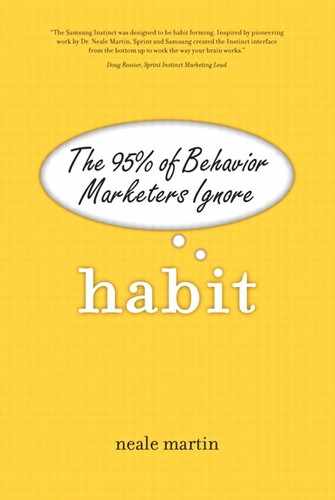The Physical Brand
A key component to a brand’s ability to help customers automate purchase and use is its physical attributes. The American Marketing Association’s definition of brand includes a name, term, design, or symbol that distinguishes products and services from competitive offerings.
Habits are created through repetition of behavior under stable conditions or contexts. Any stimuli associated with the context can become a cue that will trigger the behavior. The power of brands is that they can become the cue or the part of habitual behavior activated by a cue.
Intel faced an incredibly challenging marketing problem: how to leverage its favorable brand image when its main product was invisible to the customers who bought it. The Intel Inside campaign was effective because it combined a highly visible advertising blitz with the company’s logo on the outside of the computer. Compaq, the PC market leader at the time, declined to participate, recognizing that Intel Inside would diminish the value of its brand. However, the campaign was so successful that Compaq eventually capitulated because customers were checking to make sure Intel was the processor inside the PCs they bought.
Every aspect of the product can become a cue, especially logos, brand marks, brand names, and packaging. The Intel chime was an integral part of its successful elevation to customer awareness. When customers are shopping on autopilot, they rely on the familiarity of the physical appearance of a product, including packaging and branding, to automate their behavior. The shape of the traditional Coke bottle is an integral part of numerous marketing campaigns. Similarly, the physical appearances of stores, restaurants, and web sites can serve as cues to activate a wide range of behaviors.
Any change in appearance represents a potential risk of removing the stimulus that serves as the cue. I experienced this personally not long ago when I walked right by the box of Italian seasonings I was looking for. In a move to update the look, the manufacturer had radically changed the appearance of the box, including its distinctive color. Because I was in automatic mode, the new box was essentially invisible. I was able to find it only because it was on my list and the grocer had put the box in the exact same position on the store shelf.
The brand can also be part of the habitual response to other cues that activate behavior. Going to a bar might activate a habit of ordering a draft beer. Your normal brand isn’t available on tap, but you spy your favorite European brand on one of the tap handles. Although it’s more expensive, the decision to splurge is almost automatic. Understanding the customer’s context for a purchase is critical to understanding the heuristic they will use.
Another example from Srivatsa in the pharmaceutical field illustrates this point. “Shoppers may buy generic drugs for themselves but will buy the name brand for their loved ones. Intellectually, they know they are the same, but emotionally, they want to feel they are sparing no expense for their child or spouse.” The context determines which heuristic will be used.
The brand is both the physical representation of a product or company’s identity and the sum total experience customers have with the product or company. Both definitions are essential to habit formation. It is critical to observe customers and potential customers to understand how they interact with the brand.
Although any change to a product can impact brand perception, I cover pricing and distribution channels separately because their impact on habit formation is profound.
